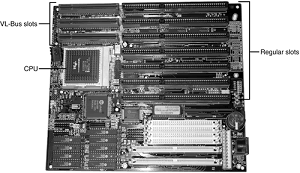VESA Local Bus
The Video Electronics Standards Association (VESA) local bus was the most popular local bus design from its debut in August 1992 through 1994. It was created by the VESA committee, a nonprofit organization originally founded by NEC to further develop video display and bus standards.
In a similar fashion to how EISA evolved, NEC had done most of the work on the VL-Bus (as it would be called) and, after founding the nonprofit VESA committee, NEC turned over future development to VESA. At first, the local bus slot seemed designed to be used primarily for video cards.
Improving video performance was a top priority at NEC to help sell its high-end displays as well as its own PC systems. By 1991, video performance had become a real bottleneck in most PC systems.
The VL-Bus can move data 32 bits at a time, enabling data to flow between the CPU and a compatible video subsystem or hard drive at the full 32-bit data width of the 486 chip. The maximum rated throughput of the VL-Bus is 133MBps. In other words, local bus went a long way toward removing the major bottlenecks that existed in earlier bus configurations.
Unfortunately, the VL-Bus did not seem to be a long-lived concept. The design was simple indeed—just take the pins from the 486 processor and run them out to a card connector socket. So, the VL-Bus is essentially the raw 486 processor bus.
This allowed a very inexpensive design because no additional chipsets or interface chips were required. A motherboard designer could add VL-Bus slots to its 486 motherboards very easily and at a very low cost. This is why these slots appeared on virtually all 486 system designs overnight.
Problems arose with timing glitches caused by the capacitance introduced into the circuit by different cards. Because the VL-Bus ran at the same speed as the processor bus, different processor speeds meant different bus speeds, and full compatibility was difficult to achieve.
Although the VL-Bus could be adapted to other processors—including the 386 or even the Pentium—it was designed for the 486 and worked best as a 486 solution only. Despite the low cost, after a new bus called PCI appeared, VL-Bus fell into disfavor very quickly.
It never did catch on with Pentium systems, and there was little or no further development of the VL-Bus in the PC industry. Physically, the VL-Bus slot was an extension of the slots used for whatever type of base system you have.
If you have an ISA system, the VL-Bus is positioned as an extension of your existing 16-bit ISA slots. Figure below shows how the VL-Bus slots are oriented on a typical ISA/VL-Bus motherboard.

The VESA extension has 112 contacts and uses the same physical connector as the MCA bus.